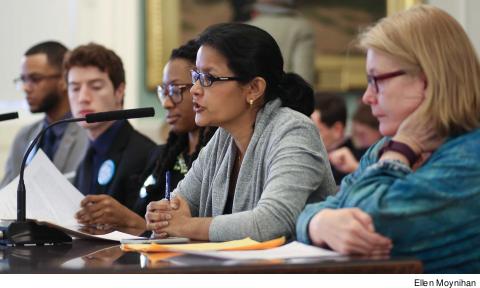 |
In the memorandum of agreement signed last year with CUNY, the university agreed to a teaching- load reduction commitment that the union had sought for nearly two decades. The two parties “are committed to a shared goal of reducing the annual undergraduate teaching contact hour workload for full-time classroom teaching members of the instructional staff by three teaching contact hours,” states the agreement.
Unlike most contract provisions, this one left two major elements – funding and implementation – to be negotiated. “It was a huge step to get CUNY to go this far,” said PSC President Barbara Bowen. “Now management is legally committed to making it happen.”
PROGRESS MADE
As mandated in the agreement, the union and the university formed a labor-management committee and began meeting last October to recommend a plan for implementing the teaching load reduction and identify resources to make the commitment a reality. The two sides have held several meetings since then, and have made progress on reaching the shared goal of reducing the course load by three credits per semester to allow full-time faculty members more time for research, mentoring and one-on-one student support.
The agreement mandates that the recommendations be implemented before a new contract is ratified. As talks on the issue continued over the previous academic year, the PSC mounted a campaign highlighting the urgency of implementing the new provision. At the end of the Spring semester, hundreds of department chairs from around the university sent a letter to both CUNY Board of Trustees Chairman William Thompson and Chancellor James B. Milliken. Their message was clear: CUNY management could not drag its feet on the issue without hurting both the quality of students’ education and departments’ ability to attract and retain faculty.
“CUNY simply cannot continue to compete for the best faculty or offer our students the support they need without the teaching load reduction,” the letter states. “Almost without exception, the department chairs whose names appear below have had the experience of losing a top candidate for a faculty position, or seeing a revered member of the current faculty leave for another job, because of the teaching load.”
The public campaign was helpful in adding urgency to the talks with management. PSC Secretary Nivedita Majumdar reported, “We are in serious discussions with CUNY about how to implement the teaching-load reduction in a way that does justice to faculty and student needs.”
Bowen added, “We have made real progress this summer. Even so, members should not expect the reduction to begin this academic year. The union is pressing hard, but it may take this year to get the funding and implementation in place so that the change can begin in the 2018 academic year.”
GETTING FUNDING
The labor-management committee must confront several challenges, including identifying the needed financial resources, which were not carved out of the most recent contract. Reducing the teaching load for all full-time classroom faculty is expensive because it means that thousands of classes previously taught by existing full-time faculty will now need new instructors. The union has argued forcefully that the new instructors should be full-time faculty and that the teaching load reduction should not contribute to the proliferation of underpaid adjunct positions at CUNY. Union negotiators see the new full-time faculty positions that would be created as an opportunity to move some current CUNY adjuncts into full-time positions and to achieve increased race and gender diversity among newly hired full-time faculty.
Bowen added, “The implementation of the commitment on teaching-load reduction will be complicated; it’s huge, it’s costly and it’s worth it.”

